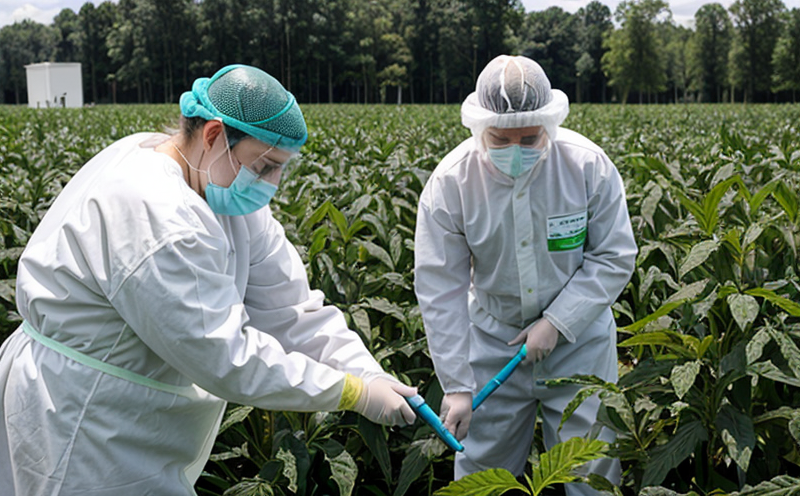Codex Guidelines for Safety Testing of Beneficial Microorganisms
The Codex Guidelines for Safety Testing of Beneficial Microorganisms are a critical framework aimed at ensuring the safety and efficacy of beneficial microorganisms used in food products. These guidelines, developed by the World Health Organization (WHO) and the Food and Agriculture Organization (FAO), provide a set of standards that help regulatory bodies and manufacturers evaluate the safety of biocontrol agents and other beneficial microorganisms intended for use in agriculture, food processing, or human and animal health.
The primary goal of these guidelines is to ensure that the beneficial microorganisms are safe for both humans and animals when used as specified. This includes assessing potential risks associated with their use, such as allergenicity, toxicity, pathogenicity, and environmental impact. The guidelines cover various stages of product development, from strain selection through commercialization.
One of the key aspects addressed by these guidelines is the need for a comprehensive safety profile. This involves not only evaluating the direct effects of the microorganism on human health but also considering indirect impacts such as interactions with other beneficial microorganisms in the ecosystem. The guidelines recommend that tests should be conducted according to internationally recognized standards, including ISO, ASTM, and EN specifications.
The Codex Guidelines emphasize the importance of understanding the specific characteristics of each biocontrol agent or beneficial microorganism being evaluated. This includes its mode of action, environmental persistence, and potential for horizontal gene transfer. The guidelines also stress the need to consider the lifecycle stages of the organism and any associated risks throughout its entire life cycle.
For quality managers and compliance officers, these guidelines provide a structured approach to ensuring that products meet regulatory requirements. They offer a roadmap for conducting thorough safety assessments while aligning with international best practices. For R&D engineers and procurement professionals, understanding these guidelines can help in selecting safe and effective biocontrol agents and beneficial microorganisms.
The Codex Guidelines also highlight the significance of transparency and communication between stakeholders involved in the development and use of beneficial microorganisms. This includes sharing data on testing methods, results, and any unforeseen issues that may arise during product development or commercialization.
By adhering to these guidelines, manufacturers can demonstrate their commitment to safety and quality, which is crucial for maintaining consumer trust and regulatory compliance. These guidelines are particularly important in the context of increasing demand for sustainable agricultural practices and safer food products.
| Stage | Description |
|---|---|
| Strain Isolation | Testing to ensure the strain is safe for intended use. |
| Toxicity Testing | Evaluating potential toxic effects on humans and animals. |
| Allergenicity Assessment | Determining if the microorganism can cause allergic reactions. |
| Pathogenicity Evaluation | Assessing the risk of pathogenic strains being introduced into new environments. |
| Ecological Impact Analysis | Evaluating potential impacts on non-target organisms and ecosystems. |
Industry Applications
- Agriculture: Enhancing crop yields and disease resistance through biocontrol agents.
- Food Processing: Ensuring food safety by using beneficial microorganisms in production processes.
- Animal Health: Developing probiotics and other supplements to promote gut health.
- Environmental Bioremediation: Utilizing microorganisms to clean up contaminated sites.
The Codex Guidelines are particularly relevant for industries where the use of biocontrol agents and beneficial microorganisms is integral. In agriculture, these guidelines help ensure that biocontrol agents do not pose risks to non-target organisms or ecosystems. For food processing companies, they provide a framework for ensuring the safety of probiotics and other supplements used in manufacturing. In animal health, these guidelines are crucial for developing safe and effective probiotics and prebiotics.
The guidelines also apply to environmental bioremediation projects where microorganisms are used to clean up contaminated sites. By following these guidelines, companies can ensure that their products meet regulatory standards and maintain a high level of safety and efficacy.
Quality and Reliability Assurance
- Strain Isolation: Rigorous testing to identify safe strains for use in various applications.
- Toxicity Testing: Comprehensive evaluation of potential toxic effects on humans and animals.
- Allergenicity Assessment: Ensuring that the microorganism does not cause allergic reactions.
- Pathogenicity Evaluation: Determining the risk of pathogenic strains being introduced into new environments.
- Ecological Impact Analysis: Evaluating potential impacts on non-target organisms and ecosystems.
- Mutagenicity Testing: Assessing whether the microorganism can cause mutations in cells.
- Lifecycle Stage Evaluation: Considering risks associated with different stages of the microorganism's lifecycle.
The Codex Guidelines require a multi-faceted approach to quality and reliability assurance. This includes not only laboratory testing but also field trials to evaluate the real-world performance of biocontrol agents and beneficial microorganisms. By conducting thorough evaluations at each stage, companies can ensure that their products meet high standards of safety and efficacy.
Competitive Advantage and Market Impact
The Codex Guidelines provide a significant competitive advantage in the market by ensuring that products are safe and comply with international regulations. This can help companies differentiate themselves from competitors who may not adhere to these guidelines, thereby gaining a reputation for quality and safety.
By demonstrating compliance with these guidelines, manufacturers can also open up new markets, particularly in regions where regulatory requirements are stringent. The guidelines provide a benchmark that consumers can trust, which is crucial in building brand loyalty and customer confidence.
In the context of R&D, following the Codex Guidelines allows companies to stay ahead of changing regulations and market demands. This proactive approach ensures that products remain safe and effective even as new technologies and applications emerge.





